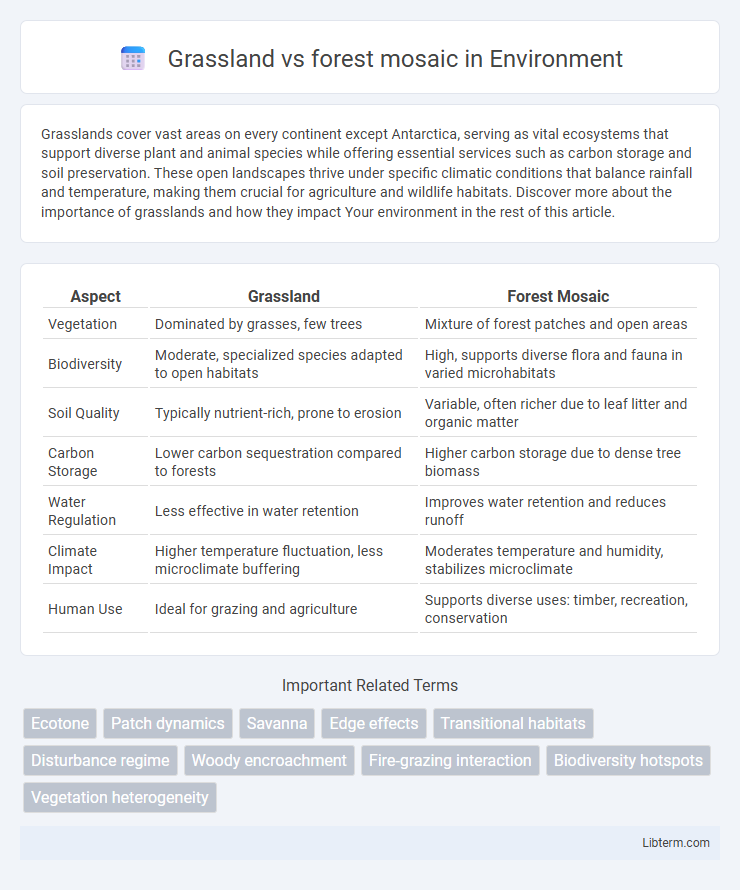Grasslands cover vast areas on every continent except Antarctica, serving as vital ecosystems that support diverse plant and animal species while offering essential services such as carbon storage and soil preservation. These open landscapes thrive under specific climatic conditions that balance rainfall and temperature, making them crucial for agriculture and wildlife habitats. Discover more about the importance of grasslands and how they impact Your environment in the rest of this article.
Table of Comparison
| Aspect | Grassland | Forest Mosaic |
|---|---|---|
| Vegetation | Dominated by grasses, few trees | Mixture of forest patches and open areas |
| Biodiversity | Moderate, specialized species adapted to open habitats | High, supports diverse flora and fauna in varied microhabitats |
| Soil Quality | Typically nutrient-rich, prone to erosion | Variable, often richer due to leaf litter and organic matter |
| Carbon Storage | Lower carbon sequestration compared to forests | Higher carbon storage due to dense tree biomass |
| Water Regulation | Less effective in water retention | Improves water retention and reduces runoff |
| Climate Impact | Higher temperature fluctuation, less microclimate buffering | Moderates temperature and humidity, stabilizes microclimate |
| Human Use | Ideal for grazing and agriculture | Supports diverse uses: timber, recreation, conservation |
Introduction to Grassland-Forest Mosaics
Grassland-forest mosaics are dynamic ecosystems characterized by the interspersion of grassland patches and forested areas, creating a diverse landscape structure. These mosaics support high biodiversity by providing varied habitats for numerous plant and animal species adapted to both open and shaded environments. Factors such as fire regimes, soil fertility, and climatic conditions play critical roles in maintaining the balance and spatial distribution within these mosaics.
Key Characteristics of Grasslands
Grasslands are characterized by vast open spaces dominated by grasses rather than large trees, featuring fertile soil that supports abundant herbaceous plants and grazing animals. These ecosystems experience moderate rainfall, typically between 250 and 750 millimeters annually, which prevents the growth of dense forests but sustains grasses and shrubs adapted to periodic drought and fire. Grasslands play a crucial role in carbon sequestration and provide habitat for diverse wildlife, including large herbivores such as bison and predators like wolves.
Defining Features of Forest Ecosystems
Forest ecosystems are characterized by dense tree cover, multilayered canopies, and rich biodiversity with complex interdependent species. These ecosystems regulate climate through carbon sequestration, maintain soil structure, and support intricate nutrient cycles. In contrast, grasslands lack tall woody vegetation and feature grasses and herbaceous plants dominating open landscapes with periodic fire and grazing disturbances.
Mosaic Landscapes: What Are They?
Mosaic landscapes consist of diverse patches of ecosystems such as grasslands and forests creating a dynamic spatial pattern that supports high biodiversity and ecological resilience. These heterogeneous environments facilitate species movement, nutrient cycling, and habitat connectivity, enhancing ecosystem services. In grassland-forest mosaics, the interplay between open grass patches and forested areas promotes varied microclimates and resource availability essential for maintaining ecological balance.
Biodiversity Differences in Grassland vs Forest Mosaics
Grassland and forest mosaics exhibit distinct biodiversity patterns, with grasslands supporting a higher diversity of herbaceous plants and specialized grassland fauna, while forest mosaics harbor a greater richness of woody plants, understory species, and canopy-dependent fauna. The structural complexity in forest mosaics allows for diverse microhabitats that support various bird, mammal, and invertebrate species, whereas grassland mosaics promote species adapted to open, sun-exposed environments and periodic disturbances like fire. The interplay between these habitats in mosaic landscapes enhances regional biodiversity by creating ecological gradients that support species with different habitat preferences and survival strategies.
Soil Composition and Nutrient Cycling
Grassland vs forest mosaic ecosystems exhibit distinct soil compositions, with grasslands typically having higher organic matter concentrated in the topsoil due to dense root systems, while forests accumulate organic layers from leaf litter and woody debris. Nutrient cycling in grasslands is accelerated by rapid root turnover and microbial activity, promoting efficient nitrogen and carbon recycling, whereas forest mosaics rely on decomposer fungi and slower mineralization processes, resulting in gradual nutrient release. These differences influence soil fertility, plant diversity, and ecosystem productivity across mosaic landscapes.
Climate Influence on Mosaic Formation
Grassland and forest mosaics are shaped by climate variables including temperature, precipitation, and seasonal variability which regulate vegetation growth patterns. Reduced rainfall and increased drought frequency favor grassland dominance, while higher moisture levels promote forest expansion. Temperature fluctuations and fire regimes further influence the spatial heterogeneity, maintaining the dynamic balance between grassland and forest patches.
Human Impacts on Grassland and Forest Mosaics
Human activities such as agriculture, urbanization, and deforestation significantly alter grassland and forest mosaics, leading to habitat fragmentation and loss of biodiversity. Overgrazing and land conversion disrupt soil structure and nutrient cycles, reducing the resilience of these ecosystems. Fire suppression and invasive species introduction further degrade the natural balance between grasslands and forests, impairing ecosystem services and carbon sequestration.
Ecological Services and Benefits
Grassland-forest mosaics provide diverse ecological services including enhanced biodiversity by supporting species adapted to both open and wooded habitats, which increases ecosystem resilience. These landscapes contribute to carbon sequestration through trees and promote soil fertility and water regulation via grassland root systems. The interplay of these habitats also supports pollination and pest control, benefiting agricultural productivity and maintaining ecological balance.
Conservation Strategies for Mosaic Ecosystems
Conservation strategies for grassland-forest mosaic ecosystems prioritize maintaining habitat heterogeneity to support diverse species adapted to both open and wooded areas. Implementing controlled burns and selective logging helps regulate succession processes, preventing dominance by either grassland or forest. Protecting habitat corridors enhances connectivity, facilitating wildlife movement and genetic exchange across the mosaic landscape.
Grassland Infographic

 libterm.com
libterm.com